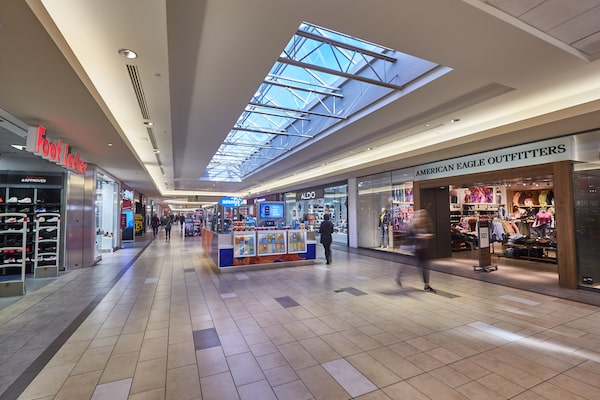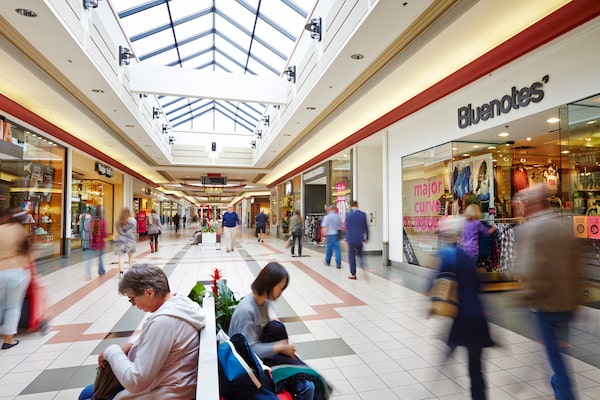
In-person shopping patterns have been shifting and they’re still changing.Brian Pieters
In one of the largest commercial real estate takeovers in Canada so far this year, Canderel Real Estate recently announced a $5.7-billion deal to buy Cominar Real Estate Investment Trust (REIT), based in Quebec City.
The move by the Montreal consortium shows confidence in a return to bricks-and-mortar shopping. While growth in online shopping is likely to continue over the long term, real estate and retail analysts also see signs that people want to go to stores in person as well.
Under the deal, expected to be completed in early 2022, some of Cominar’s assets, which total 310 buildings with 35.7 million square feet of space, will be resold to other companies. Much of the resold property is in industrial or office space.
When people say bricks-and-mortar shopping is dead, I have a hard time agreeing with that.
— Luciano D’Iorio, regional president, Quebec, CDN Global
The properties being acquired and retained by the Canderel-led consortium, called Iris Acquisition II LP, include well-known major shopping complexes in and around Montreal, such as the Alexis Nihon complex, the Rockland Centre, Centre Laval and the city’s downtown railway hub, Central Station, which has retail.
The fact that a major property consortium is betting on people going shopping again is significant, says Luciano D’Iorio, regional president, Quebec, for CDN Global, a nationwide group of real estate advisers.
“It’s a phenomenon we’re seeing in Quebec, and I think in other parts of Canada and North America as well,” he says. “People want to get out and go shopping.”
On the commercial retail real estate side, he adds, “we’re seeing demand among prospective buyers now for grocery, convenience stores and quick-service restaurants.”
Big-box retailers are also predicting people will get away from their laptops and show up to shop, Mr. D’Iorio adds.
He points out that in suburban Montreal, for example, Costco recently built a new store that’s 20 per cent larger than the existing store it’s replacing, yet they’re keeping the existing store open as well, to cater to small-business customers. Costco has made a similar expansion move in Ontario’s Niagara region, too.
“When people say bricks-and-mortar shopping is dead, I have a hard time agreeing with that,” Mr. D’Iorio says.
While there are signs that people want to shop in-store, retail property patterns are shifting in complex ways. For example, the Hudson’s Bay Co.’s flagship store in downtown Montreal is downsizing by about 45 per cent to 295,000 square feet of retail from 655,000 square feet, with a 25-storey office tower to be developed above.
In-person shopping patterns have been shifting and they’re still changing, says Linda Farha, president of Pop-Up Go, a four-year-old company that connects brands with landlords to create pop-up stores and short-term rentals.
“Buildings and malls with vacancies want to fill their spaces with pop-ups to create an interest in their location,” she says. Naturally, landlords prefer longer-term leases, but a pop-up store that lasts a few weeks or a short-term rental of six months or less is less risky for the retailer, she explains.
“Pop-ups and short-terms let both retail brands and owners look at the viability of a location for a longer lease,” Ms. Farha says.

In September, the NPD Group’s 2021 E-Commerce Channel Report noted that in the first half of this year, 82 per cent of Canadian consumers made an online purchase.
“Some pop-ups last only 10 days, with the idea of creating FOMO for shoppers – fear of missing out,” she says. “Sometimes, it’s to test the market in a particular place for a long haul. In all cases, a pop-up is about creating something unique that’s going to draw people to show up.”
However, it’s not as though online shopping is fading. In September, the NPD Group’s 2021 E-Commerce Channel Report pointed out that in the first half of this year, 82 per cent of Canadian consumers made an online purchase, and that online shopping visits grew by more than 25 per cent between June, 2020, and June, 2021.
This is part of a longer-term trend that predated COVID-19, though, says Tamara Szames, director of Canada retail at the NPD Group. The move toward online was happening already, but the lockdowns “accelerated the growth of the [online] channel by almost five years,” she says, in a statement accompanying the report’s release.
Some property owners are trying a hybrid approach, mixing the mall experience with online shopping.
Primaris, which owns and manages more than 7.5 million square feet of commercial space across Canada, has partnered with multichannel platform Dropit, to launch Primarché, an omnichannel shopping centre marketplace.
According to Primaris, it is the first-ever retail innovation to digitize real-time store inventory within the company’s national shopping network into one marketplace.
Consumers can shop the mall’s stores online in five Primaris locations, with more to come – Dufferin Mall in Toronto, Stone Road Mall in Guelph, Ont., Cataraqui Centre in Kingston, Orchard Park Mall in Kelowna, B.C., and Park Place Mall in Lethbridge, Alta. – and have purchases delivered from individual or multiple stores in the mall to their homes.
Industry experts who analyze retail and real estate patterns agree that shoppers’ patterns that started to change prepandemic are still emerging.
Whatever direction shoppers go in, Mr. D’Iorio says commercial properties will always adapt to new retail realities.
“Real estate is both static and dynamic at the same time,” he says. “The buildings are there, and they tend to stay there, but [property owners and retailers] are always trying to repurpose them to what people want and what they need.”